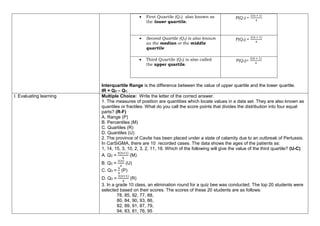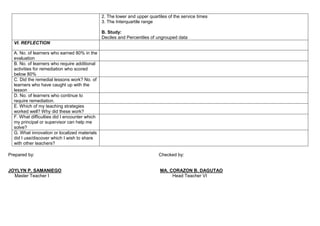Daily Lesson Plan in Mathematics Quarter 4
- 1. GRADE 10 DAILY LESSON PLAN School GMATHS Grade Level 10 Teacher JOYLYN P. SAMANIEGO Learning Area MATHEMATICS Teaching Date and Time APRIL 1, 2024 12:00 PM- 12:50 PM Quarter FOURTH Session 1 I. OBJECTIVES 1. Content Standards The learner demonstrates understanding of key concepts of measures of position. 2. Performance Standards The learner is able to conduct systematically a mini-research applying the different statistical methods. 3. Learning Competencies Objectives The learner: illustrates the following measures of position. (M10SP-Iva-1) calculates a specified measure of position. (M10SP-IVb-1) 1. Illustrate the quartiles (Q1, Q2, and Q3) for ungrouped data. 2. Calculate the value of quartiles for ungrouped data. 3. Appreciate the concept of quartiles in real life. II. CONTENT QUARTILE (UNGROUPED DATA) A. References 1. Teacher’s Guide Callanta, M.M, et.al. Mathematics Grade 10 Teachers Guide. Meralco Avenue, Pasig City, Philippines 1600: Department of Education 2015: Pages 324-331 2. Learner’s Materials Callanta, M.M, et.al. Mathematics Grade 10 Module. Meralco Avenue, Pasig City, Philippines 1600: Department of Education 2015: Pages 366-367 3. Textbook Torio, V. G, et.al. (2017). Smart in Math 10. ISA-JECHO PUBLISHING, INC. Pages 342-344; 347- 350 4. Additional Materials from Learning Resources (LR) portal B. Other Learning Resources IV. PROCEDURES
- 2. A. Reviewing the previous lesson or presenting the new lesson A. Preliminary Activities 1. Prayer 2. Greetings 3. Classroom Guidelines C. Numeracy Drill Simplify: 1. 7+1 4 = 2. 2(5+1) 4 = 3. 3(5+1) 4 = D. Motivation GUESS THE GIBBERISH! Read the gibberish aloud to guess the hidden word. 1. Mash Or 2. Pose It Shun 3. Un Grew Ped 4. Dot Ah 5. Quart Isle B. Establishing a purpose for the lesson WHAT’S YOUR BMI? A. Call eight students to come in front and arrange themselves according to height. Ask a student to divide them into four equal parts to illustrate the quartiles. B. Ask the same set of students to calculate their BMI and write them on a piece of paper and then post it on the board. Calculate the lower quartile (Q1), median (Q2), upper quartile (Q3), and the interquartile range using the steps provided. Solution: 1. Arrange the data in increasing order. _____________________________ 2. Locate the position of Q1 in the distribution using Qk position = 𝑘(𝑛+1) 4 , where k is 1 (Round off to the nearest whole number if needed.) 3. Determine the value of Q1 based on its position. 4. Locate the position of Q2 in the distribution using Qk position = 𝑘(𝑛+1) 4 , where k is 2 5. Determine the value of Q2 based on its position C. Presenting examples/Instances of the new lesson MELC Integrated: Assesses physical activity, exercise, and eating habits( PE10PF-Ia-h-39)
- 3. 6. Locate the position of Q3 in the distribution using Qk position = 𝑘(𝑛+1) 4 , where k is 3 (Round off to the nearest whole number if needed.) 7. Determine the value of Q3 based on its position. 8. Calculate interquartile range 9. IR = Q3 – Q1 D. Discussing new concepts and practicing new skills # 1 1. How did you find the activity? 2. How do you describe quartiles? 3. What are the formulas in locating the position of the quartiles for ungrouped data? 4. What are the steps In finding the value of quartiles for ungrouped data? 5. How do you calculate the interquartile range? E. Discussing new concepts and practicing new skills # 2 This activity is to be done by group in 5 minutes. A minute is to be given for them to post their work on the board. TANGKILIKIN ANG SARILING ATIN! The indigenous peoples of the Cordillera in Northern Luzon, Philippines are referred to as the Igorot People. They are recently called as the Cordilleran Peoples. The Arts and Crafts of the Igorot People showcase the rich cultural heritage of the Philippines. As one of the indigenous groups in the country, they are known for their exceptional handiwork such as weaving, woodcarving, and beadwork. These handicrafts not only serve as a source of livelihood for the Igorot community. F. Developing mastery (leads to Formative Assessment 3) G. Finding practical application of concepts and skills in daily living
- 4. To help the Igorot community, a souvenir shop sells some of their woodcarvings. One day, the owner of the shop became curious on the ages of the tourists who show interest on these arts and crafts. On that certain day, he recorded the ages as follows: 16, 19,23,21,43,52,45,47,49,32,43,31,56,63, 33,36,39,44,41,40 1.Calculate the following: a. Q1 b. Q2 c. Q3 d. Interquartile Range 2. Suppose a tourist came and the value of Q1 does not change, what must be the age of the tourist? 5 3 1 Completion Was able to provide solutions to all the questions Was able to provide solutions to some of the questions. Was able to provide solutions to only one question. Accuracy All of the answers are correct Most of the answers are correct. Little to none of the answers are correct Timeliness The output is posted on time. The output is posted beyond the allotted time The output is the last to be posted beyond the allotted time H. Making generalizations and abstractions about the lesson The measures of position are quantities which locate values in a data set. They are quartiles, deciles, and percentiles also known as quantiles or fractiles. Quartiles (Q1, Q2, Q3) The quartiles are points that divide a ranked data into four equal parts. Each set of data has three quartiles. DESCRIPTION FORMULA FOR THE POSITION OF QUARTILE
- 5. First Quartile (Q1) also known as the lower quartile. P(Q1) = 1(𝑛 + 1) 4 Second Quartile (Q2) is also known as the median or the middle quartile P(Q2) = 2(𝑛 + 1) 4 Third Quartile (Q3) is also called the upper quartile. P(Q3)= 3(𝑛 + 1) 4 Interquartile Range is the difference between the value of upper quartile and the lower quartile. IR = Q3 – Q1. I. Evaluating learning Multiple Choice: Write the letter of the correct answer. 1. The measures of position are quantities which locate values in a data set. They are also known as quantiles or fractiles. What do you call the score points that divides the distribution into four equal parts? (R-F) A. Range (P) B. Percentiles (M) C. Quartiles (R) D. Quantiles (U) 2. The province of Cavite has been placed under a state of calamity due to an outbreak of Pertussis. In CarSiGMA, there are 10 recorded cases. The data shows the ages of the patients as: 1, 14, 15, 3, 10, 2, 3, 2, 11, 18. Which of the following will give the value of the third quartile? (U-C) A. Q3 = 4(𝑛+1) 4 (M) B. Q3 = 3(𝑛) 4 (U) C. Q3 = 𝑛 4 (P) D. Q3 = 3(𝑛+1) 4 (R) 3. In a grade 10 class, an elimination round for a quiz bee was conducted. The top 20 students were selected based on their scores. The scores of these 20 students are as follows: 78, 85, 92, 77, 88, 80, 84, 90, 93, 86, 82, 89, 91, 87, 79, 94, 83, 81, 76, 95
- 6. How many students belong to the lower quartile? (Ap-P) A. 1 student (U) B. 4 students (M) C. 5 students (R) D. 11 students (P) 4. A researcher collected the fifteen data points on the ages of a group of individuals: 31, 23, 24, 37, 27, 26, 25, x, 35, 28, 36, 29, 30, 34, 33. Given that Q1 is equal to 26, which is the correct value of x? (An-M) A. x > 26 (M) B. x < 26 (P) C. x ≥26 (R) D. x ≤ 26 (U) 5. The teacher asked the students to give a set of data where in the interquartile range is equal to 5. Which of the following are the possible data? (C-P) A. 3, 3, 4, 5, 5, 8, 9, 10, 12 (M) B. 8, 8, 8, 9, 9, 12, 13, 15, 15, 16 (U) C. 6, 6, 8, 10, 15, 17 (P) D. 5, 8, 9, 9, 10, 10, 11, 12, 14, 14, 17 (R) J. Additional activities for application or remediation A. Follow Up: Mr. O. Javier, a bank manager, is interested in the amount of time it takes his teller to service depositors. On a particular morning, he asked his secretary to record the service times for 15 customers. The times are given below (to the nearest minute) 6, 9, 7, 5, 15, 10, 9, 7, 4, 9, 10, 9, 8, 6, 7 Find: 1. The median time 2. The lower and upper quartiles of the service times 3. The Interquartile range B. Study: Deciles and Percentiles of ungrouped data V. REMARKS A. Follow Up: Mr. O. Javier, a bank manager, is interested in the amount of time it takes his teller to service depositors. On a particular morning, he asked his secretary to record the service times for 15 customers. The times are given below (to the nearest minute) 6, 9, 7, 5, 15, 10, 9, 7, 4, 9, 10, 9, 8, 6, 7 Find: 1. The median time
- 7. 2. The lower and upper quartiles of the service times 3. The Interquartile range B. Study: Deciles and Percentiles of ungrouped data VI. REFLECTION A. No. of learners who earned 80% in the evaluation B. No. of learners who require additional activities for remediation who scored below 80% C. Did the remedial lessons work? No. of learners who have caught up with the lesson D. No. of learners who continue to require remediation. E. Which of my teaching strategies worked well? Why did these work? F. What difficulties did I encounter which my principal or supervisor can help me solve? G. What innovation or localized materials did I use/discover which I wish to share with other teachers? Prepared by: Checked by: JOYLYN P. SAMANIEGO MA. CORAZON B. DAGUTAO Master Teacher I Head Teacher VI






